Getting My Open Water Diver Certification
My life has always include the ocean. Growing up, our family holidays were spent surfing, snorkelling, and fishing at Cape St. Francis (South Africa). And when we weren’t holidaying there, we were often rock fishing in the Transkei. I have many a fond memory of free-diving for abalone with my father in the cool Atlantic waters of Cape Town, before we moved to Durban. I then got into fly fishing, and spent many a year targeting trevally (and multiple other game species) in the salty water of Cape Vidal. And then, after arriving in Australia, one of my first purchases was a Hobie kayak to get me out onto Sydney Harbour. I just can’t seem to escape it.
So when an excuse (finally) landed on my doorstep (in the form of an invite from friends to join them on a diving holiday), Sharon and I jumped at the opportunity and immediately headed out to get Open Water certified. Being December, and still under some level of Covid restrictions, the majority of the classes were already full. As such we booked a private instructor through Frog Dive, and boy am I glad we did.
Our experience kicked off immediately as a ream of online training material landed in our inboxes. The material consisted of 5 sections, as well as a final exam. Each section contained multiple sub-sections (including skills, equipment, problem management, and more), and was made up of both written text, as well as video content. Getting the material upfront meant less time in the classroom later on, and it took us roughly an hour per module, which we completed in the evenings.
Day 1 – The Pool
Having both passed the online exam, we arrived at the Frog Dive pool on a chilly, rainy morning, with a cup of coffee in hand. I had visions of spending the day freezing my ass off in an ice cold pool, so I was ecstatic to discover that the pool was beautifully heated. Our instructor introduced himself, and told us a few stories from his 35+ years of diving experience.
As it turned out, he was a passionate underwater photographer (and also taught the PADI Underwater Digital Photography course, which gave us plenty to discuss over the upcoming 3 days of diving. Graham also co-authored the book, The Dive Spots of New South Wales, and was an absolute wealth of knowledge.
Graham did a great job at getting us excited about diving, as well as understanding what we personally wanted to get out of the experience. With the ice broken, we went through a short informal test to ensure we’d completed our (own) online exams, and then spent 30 minutes discussing the results. And with that, it was time to get practical.
This meant gearing up, which included a quick trip to the Frog Dive shop to purchase Sharon a mask and snorkel. I already had a mask from my snorkelling days back in South Africa, so there was sadly no new gear for me. Other than our masks and snorkels, we were given booties and then loaned wetsuits, BCDs, regulators, cylinders, fins, and so on.
Finally at the pool we did our swim test, which included swimming 200 meters non-stop, followed by treading water for 10 minutes unassisted. It’s not a difficult test, but safety comes first when you’re operating in an environment as harsh and unforgiving as the underwater world.
And with that the real fun started – we began familiarising ourselves with our equipment, including learning to read cylinder markings, and setting up our BCDs. As complicated as it looks, it really is a very simple process. But again, it’s all about safety and double checking everything for both yourself and your buddy.
Kitted up we jumped into the pool and started going through the skills. For me this didn’t last long as my South African mask failed immediately, and I was forced to exit the pool and head into the shop, dripping with water, to purchase a new mask (woohoo, new gear). With my new mask on my face, we continued through the skills, which included breathing through the regulator, clearing our masks underwater, regathering our regulators underwater, breathing from a free flowing regulator, hand signals, and so on.
By this stage it was lunchtime, and we received an unexpected bonus. Frog Dive had held it’s annual Christmas party the night before, and there was a LOT of left over food. This meant that instead of the standard sausage sizzle, we also nibbled on kebabs, prawns, and oh so much more. I also took this opportunity to change masks, as the one I’d bought didn’t fit my face well and leaked in the pool.
Belly’s full, we completely disobeyed our granny’s advice and got straight back into the water (without waiting the obligatory 30 minutes). This time we headed to the deep end, and learned a few new skills including ascending, descending, buoyancy, out of air, alternate air, no mask swims, giant strides, and more. Again, none of these skills are complicated, but all of them are important and need to become second nature.
Part of the fun during the pool dive was finding all the left overs from the Christmas party. These included a toe ring, multiple champagne glasses, and water soaked streamers.
And with that, our first day was done (it was just after 2pm). We dis-assembled and cleaned our gear, filled in some paperwork, and picked up full tanks and dry wetsuits for the next day’s dives.
Day 2 – Our First Dives at Chowder Bay (Clifton Gardens)
Day 2 was when the real fun started – our first dives. Thankfully the rain held off as we drove into Chowder Bay at Clifton Gardens. The day was a lot about repetition of skills, and we started the day by repeating our learnings by assembling our equipment.
Sharon was slightly nervous about her first dive, especially considering the visibility at Chowder Bay is generally poor, and looked to be no more that 3 meters on this occasion. Thankfully Graham did an amazing job keeping her both calm, as well as excited. He also taught us about the venue, including about the military installation and some of the wrecks in the area.
We walked to the water, tanks on our backs, and waded out into the unknown. We repeated all of the skills in shallow water (roughly 8 meters), including cramp release, tows, clearing masks, removing and replacing weights, CESA (Controlled Emergency Swimming Ascent), buoyancy, and so on. Clifton Gardens in a muck dive, meaning the bottom is predominantly sand, which makes it a great venue to learn at.
With our skills completed, we headed out for our first dive. This involved exploring around the pylons under the peer. Despite the poor visibility, it was an incredible experience and we were privileged to find seahorses, octopuses, cuttlefish, moray eels, leather jackets, old wives, pipefish, sea urchins, and hundreds of glass fish. I was especially excited that I spotted the seahorse, as it had been a lifelong dream of mine to see these in the wild, so to experience this on my first dive was a massive win. Other than the fauna, the colours on the sponges were amazing, especially when lit by the torch. My buoyancy was better than expected, while Sharon did struggle a little (and even accidentally porpoised). It was a great first dive.
Back on the shore we had a quick snack, which included a cup of hot coffee and a few egg mayonnaise sandwiches. We swapped our empty tanks out for full ones, and chatted about our experiences.
We needed to cover far fewer skills on dive 2 than on dive 1, so most of the time was spent enjoying an actual dive. We opted to head out to deeper water in search of some small wrecks, rather than loops back around the same pylons. This made Sharon nervous, but again, Graham did a fantastic job at easing her nerves.
We swam out from the jetty until we found a chain, and then navigated along it until we located the wrecks. This took us down to a depth of 16 meters, and we saw octopuses, decorator crabs, and many more fish species that I’m currently unable to identify. Again, it was incredible!
Sharon got a little nervous towards the end of this dive as she was running low on gas, and didn’t realise we’d turned and were almost back at shore. In her mind she was going to run out of air, and we were ignoring her frequent updates on her low levels. I knew what was going on, but was unable to communicate this underwater, something we were going to need to get used to.
Back at the shop we cleaned our gear, completed the necessary paperwork, and picked up full tanks. We then replanned the next days diving, which included a last minute change of location due to Covid. We were originally scheduled to dive at Shelly Beach (Manly), but weren’t allowed into the area as it had been declared a Covid hotspot, and had gone into lockdown. As such we pivoted to Bare Island, which turned out to be a key location in Mission Impossible 2. This news saw us trying to watch Mission Impossible 2 that evening, but we were pretty tired and fell asleep well before we got to the Bare Island scenes.
Day 3 – Diving Bare Island
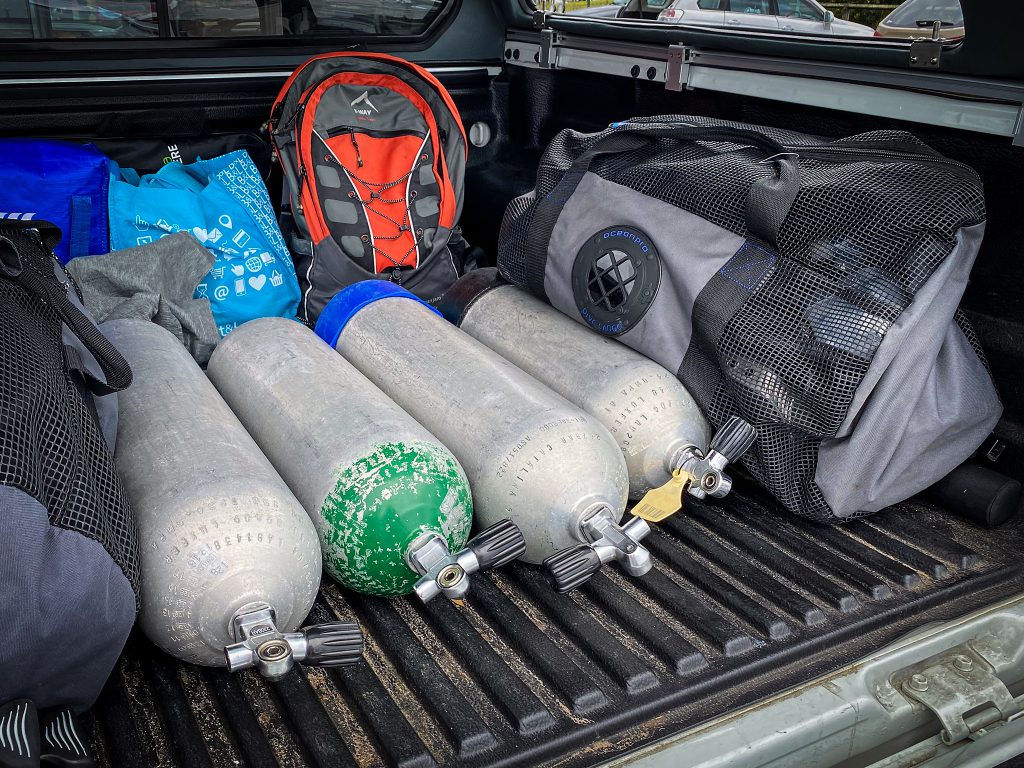
Kitted up for a double dive at Bare Island 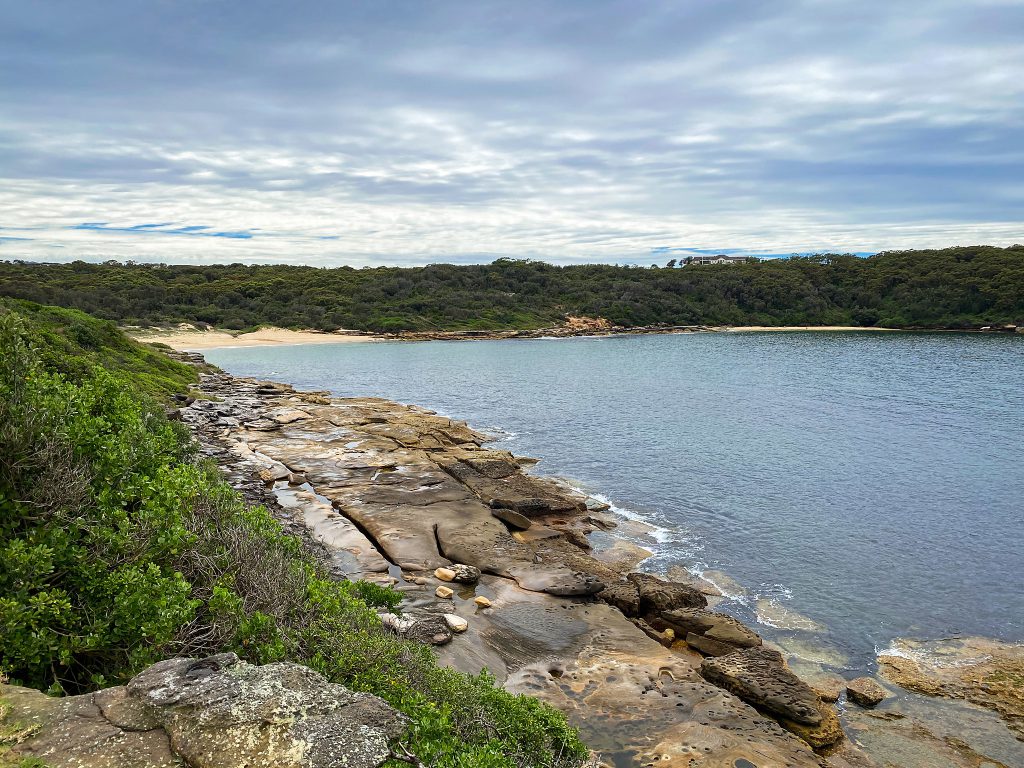
Looking back to Congwong Beach 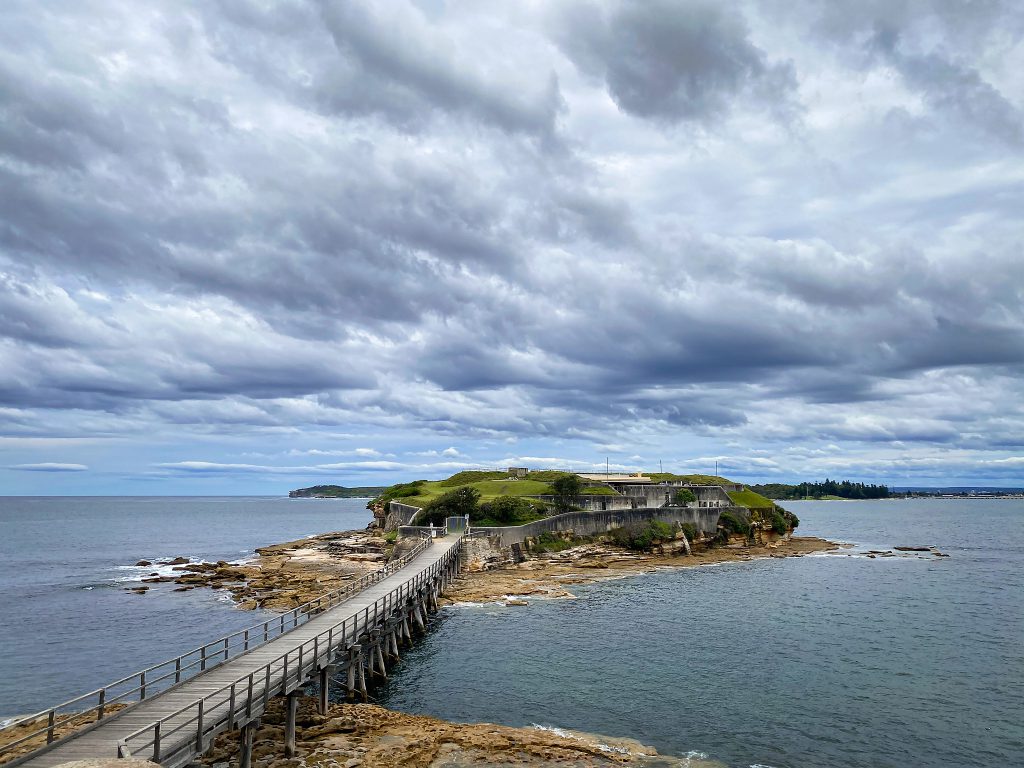
Bare Island
The next morning we headed south to Bare Island in La Perouse. I was immediately impressed by the beauty of the venue, and wondered why we’d never visited before, even if just for the nearby beaches.
We started the morning on the grass, learning to use a compass. It must have been quite a sight seeing us walking around the park, towels covering our heads, testing out our navigational skills.
With the groundwork set, we set up our equipment, and again ran through all of the safety checks. The walk down to entry point was long but scenic. I especially enjoyed walking past the sign showing the number of people who had died on the island. I assumed (or hoped) that this related to fisherman who had been washed off the rocks, rather than divers who had been taken by sharks.
The entry here was somewhat different as we needed to enter from the rocks, into water that was too shallow for a giant stride. The approach we were taught was to belly flop into the water with an inflated BCD. The BCD protects you from any pain, and the air in it prevents you from going too deep. Sharon’s tank was slightly too high in her setup, which saw her bumping her head on the valve during her belly flop, leaving her panicked that there might be blood in the water. I then entered the water behind her, only to discover that she had also lost a fin in the process. Fun and games!
Finally all in the water and ready to go, we swam out to a sandy spot and practiced our navigation skills on the bottom. This involved swimming on a heading for a set number of kicks, before turning 180 degrees and swimming back to the same spot (hopefully). Being over sand there were no “landmarks” to follow, so you were fully dependant on the compass to find your way back to the buoy.
During this exercise I spotted a turtle, but decided not to interrupt the lesson, so neither Sharon nor the instructor saw it. With all of the skills now completed, we got to enjoy diving for the rest of the day.
Our first dive was on the west side of the island, and it was phenomenal. Visibility was significantly better than at Clifton Gardens, and we got to swim over a wide variety of brightly coloured sponges, with the sea tulips being a highlight. We also saw stingrays, flathead, estuarine catfish, an incredible variety of nudibranchs, and a few more octopuses. Graham also introduced us to one of the local eastern blue gropers, who would swim right up to your mask if you scratched on your BCD.
The exit was interesting as Graham taught us to ride a wave onto the rocks. And while it may be effective, it’s certainly not glamourous.
Back at the car we enjoyed a hotdog and coffee, while we watched another group arrive, who were clearly also doing their open water. We were absolutely amazed by the sheer size of the group, with appeared to be in excess of 10 divers per instructor, making us grateful to be in our little group of 2.
For our second dive we entered at the same spot, but this time we snorkelled under the bridge, to the east side of the island. Despite being so close to our morning’s dive site, the underwater world was completely different, with multiple large boulders containing many a hole for critters to hide in.
Early on the dive I spotted a good looking squid jig stuck in the kelp, which I promptly tried to retrieve. This saw Sharon somehow shouting at me through her regulator, concerned that I would get tangled in the fishing line, which I promptly proceeded to do. With that out of the way we saw shoals of pomfrit and maydo, as well as a few more stingrays. But the highlight of the dive was seeing a giant cuttlefish, with it’s tentacles erect, which was an immensely impressive sight in terms of both its colouration as well as it’s size. Oh, and we also saw an incredible starfish.
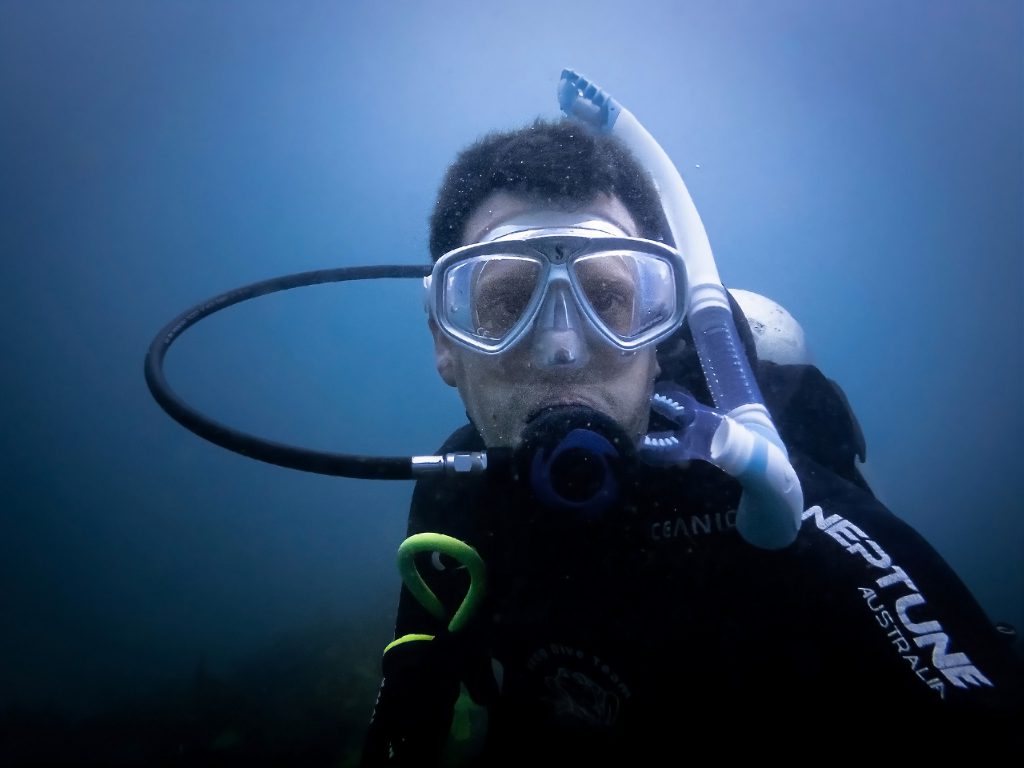
Warren diving at Bare Island 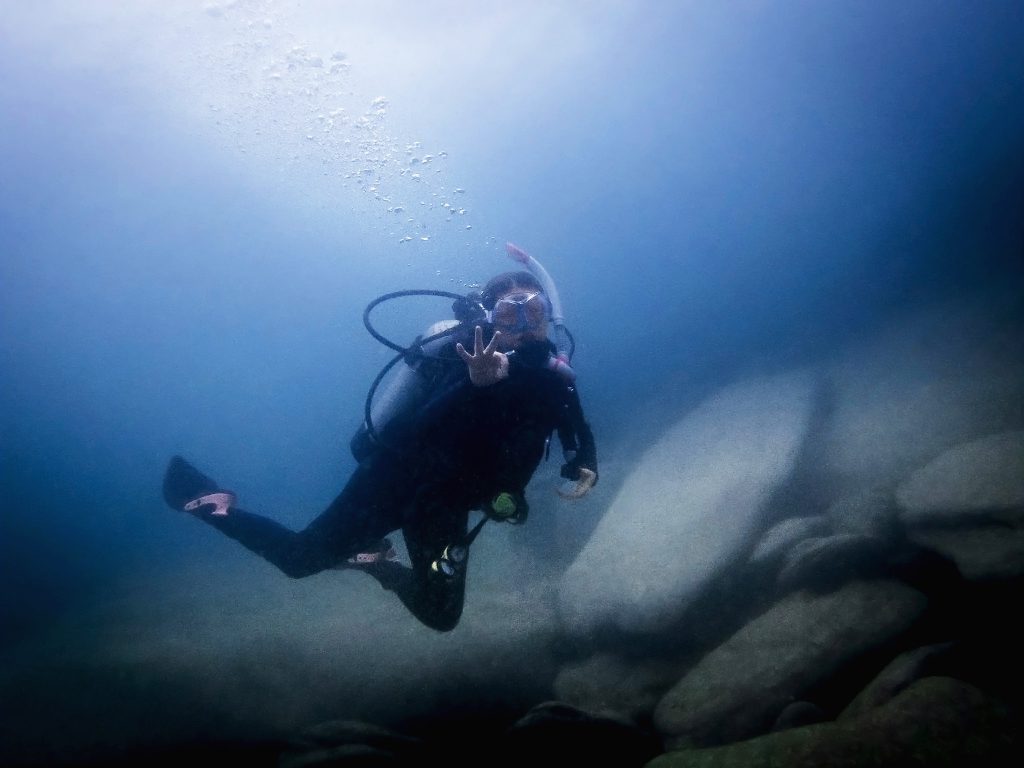
Sharon during her Open Water course
During this dive the group of 10 passed by us, and it was truely a sight to behold. They were all over the water column, battling with trim and buoyancy, and generally battling. This reaffirmed my belief that if you are planning on doing your open water, it’s well worth spending the extra money to make sure you’re in a small group.
And with that it was over. We swam back against the current, under the bridge, and climbed out on the rocks. Graham shook our hands, and told us we’d passed the course and were certified. We high-fived, we cheered!
After packing up we headed back to the shop where we cleaned our gear and completed our final paperwork. This was done in the Bridgeview Hotel, over an ice cold beer, and salt and pepper calamari…and I only felt a little bit of guilt for eating it.